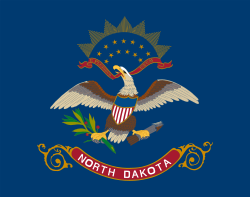| North Dakota Highway Patrol | |
|---|---|
 Patch of North Dakota Highway Patrol | |
 Badge of North Dakota Highway Patrol | |
 Flag of North Dakota | |
| Abbreviation | NDHP |
| Agency overview | |
| Formed | 1935 |
| Employees | 197 (as of 2021) [1] |
| Annual budget | $63,811,414 Million USD [2] |
| Jurisdictional structure | |
| Operations jurisdiction | North Dakota, USA |
| Size | 70,762 square miles (183,270 km2) |
| Population | 779,094 (2020 est.) [3] |
| Legal jurisdiction | |
| General nature | |
| Operational structure | |
| Headquarters | Bismarck, North Dakota |
| Troopers | 159 (authorized, as of 2022) [4] |
| Civilians | 40 (as of 2021) [5] |
| Elected officer responsible | |
| Agency executive |
|
| Parent agency | North Dakota State Cabinet |
| Regions | 4 |
| Facilities | |
| Aircraft | Cessna 206 DJI Matrice 300 RTK |
| Website | |
| NDHP Website | |
The North Dakota Highway Patrol, also known as the North Dakota State Patrol, is the state police and highway patrol agency for North Dakota, with jurisdiction over the entire state. It is a division of the North Dakota State Cabinet. Colonel Daniel J. Haugen has been serving as the 18th superintendent since December 15, 2024.
Contents
- Regions
- Highway Patrol symbol
- Firearms
- Rank structure
- Special Assignments
- Superintendents of the North Dakota Highway Patrol
- Fallen officers
- Vehicles
- See also
- References
- External links
North Dakota Highway Patrol established in 1935 by the North Dakota Legislative Assembly.
North Dakota state troopers, when hired, attend the Law Enforcement Training Academy in Bismarck. It is a 22-week program in which the recruits learn all Peace Officer Standards and Training as well as advanced traffic information. Troopers are assigned to many different post locations within the four regions upon graduating from the Academy.
Major activities of the State Patrol include: traffic enforcement, crash investigation, reporting road conditions, and enforcement of laws where state property is involved. A major duty of a North Dakota state trooper is the ability to work independently and exercise good judgement accordingly. This may differ from other peace officer agencies where operations are teamwork oriented.







